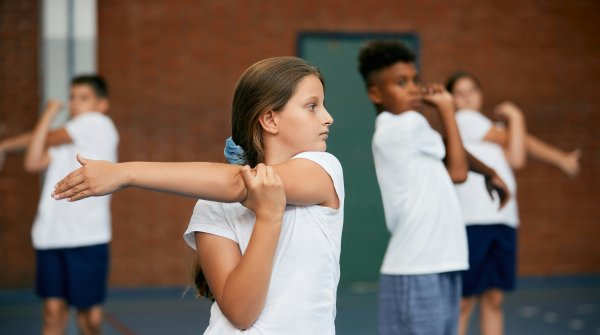Acro Yoga also includes elements from cheerleading or circus acrobatics. Acro Yoga is significantly more strenuous and demanding than the other yoga styles. Therefore, this form is also more prone to injury.
The beginnings of Acro Yoga can be traced back to Krishnamacharya. The Indian yoga teacher made a contribution to modern yoga. He developed many of the exercises now known as Acro Yoga as early as 1938. For him, the focus was on "therapeutic flying". However, he did not yet use the name Acro Yoga for it, of course.
Around the turn of the millennium, it was primarily the yoga schools AcroYoga Montreal in Canada and AcroYoga Inc. in California that made a name for themselves in acrobatic yoga. Both have helped to bring this style into the consciousness of a broad mass. Today, "Acroyoga" is a trademarked term. Only certified teachers who have studied and been certified at Jenny Sauer-Klein and Jason Nemer's school are allowed to use it.
Because of the pair or group approach, there are three different roles in Acro Yoga. These are
- Base
- Flyer
- Spotter
Basis: The person holding this role lies on the floor in a supine position for many exercises. Contact with the flyer is usually made via the hands and feet. A lot of strength is required from the base.
Flyer: The flyer moves above the base performing dynamic exercises. The basic requirements are a good sense of balance, self-confidence and strength and stability in the trunk.
Spotter: This person observes the interaction between the base and the flyer. He or she gives hints and feedback so that the trainees can improve. He or she also makes sure that the flyer lands safely in case of a fall.
Basically, the concept of Acro Yoga is that base and flyer exchange their roles. But especially when couples practice Acro Yoga together, often the stronger man is the base and the lighter woman is the flyer.
Two styles have become established in Acro Yoga:
- L-Base: Here the base lies on the ground and stretches the legs into the air. This L-shape has given the style its name. The weight of the flyer is mostly on the legs of the person lying down. Exercises in this form can usually be held longer.
- Standing: Here the base is upright. The weight of the flyer rests mainly on the hands and shoulders. The exercises are performed for a shorter period of time.
Acro Yoga classes are now available in most major cities. They are often offered by targeted instructors in gyms. AcroYoga Inc. alone has now trained and certified over 1000 instructors.
In many schools, the focus is less on the therapeutic aspect and more on the acrobatic aspect. As a beginner, it is recommended to attend a special beginner's course.
Like any other yoga class, an Acro Yoga session follows a structured structure. It usually begins with a sitting circle. This is for communication and to encourage openness in the group.
This is followed by the warm-up to get the muscles in the right mood for the demanding exercises. Here, each participant warms up for himself. Now it's time for the first partner interactions.
First asanas are performed together with the partner. The main point here is to promote trust between the two actors. Now the main part follows and the trainer leads the acrobatic exercises.
When you practice Acro Yoga with your partner, it strengthens mutual trust, but also trust in yourself. On the one hand, the base experiences the strength he or she carries within. And the flyer experiences how he or she is safely carried and can float in the air through his or her own body control. In addition, body awareness is strengthened. Strength and coordination benefit as well.
Acro Yoga makes very different demands on fitness than classical yoga does. Therefore, it is important to be aware of your own body. Numerous exercises in Acro Yoga require quite a bit of strength.
This is especially true for the basis. But if you have this or are willing to build it up, Acro Yoga is just the right thing for you. Basically, Acro Yoga is a mixture of strength, flexibility and technique.
If you don't have trouble with the crow, shoulder stand, boat, warrior 3 or other challenging exercises in a classical yoga class, Acro Yoga may be just the evolution for you.
It makes perfect sense to build your strength before your first Acro Yoga session by doing specific strength exercises such as push-ups, side supports, handstands, burpees, etc.
The most popular Acro Yoga exercises include:
- Front Bird: Here, the base lies supine on the floor. The legs are stretched upwards and the flyer lies above the base with his body stretched out.
- The Throne: Here the base also lies in L-position on the back. The flyer sits with his buttocks on the soles of the base, supporting himself with the soles of his feet in the hands of the base.
- The Whale: In the Whale, the base is again in the L position. The flyer rests his shoulders on the soles of the feet. The base supports the flyer's ankles.
 Know-HowThe 11 Best TRX Exercises
Know-HowThe 11 Best TRX Exercises
- ISPO awards
- Mountain sports
- Bike
- Design
- Retail
- Fitness
- Health
- ISPO Job Market
- ISPO Munich
- ISPO Shanghai
- Running
- Brands
- Sustainability
- Olympia
- OutDoor
- Promotion
- Sports Business
- ISPO Textrends
- Triathlon
- Water sports
- Winter sports
- eSports
- SportsTech
- OutDoor by ISPO
- Heroes
- Transformation
- Sport Fashion
- Urban Culture
- Challenges of a CEO
- Trade fairs
- Sports
- Find the Balance
- Product reviews
- Newsletter Exclusive Area
- Magazine




